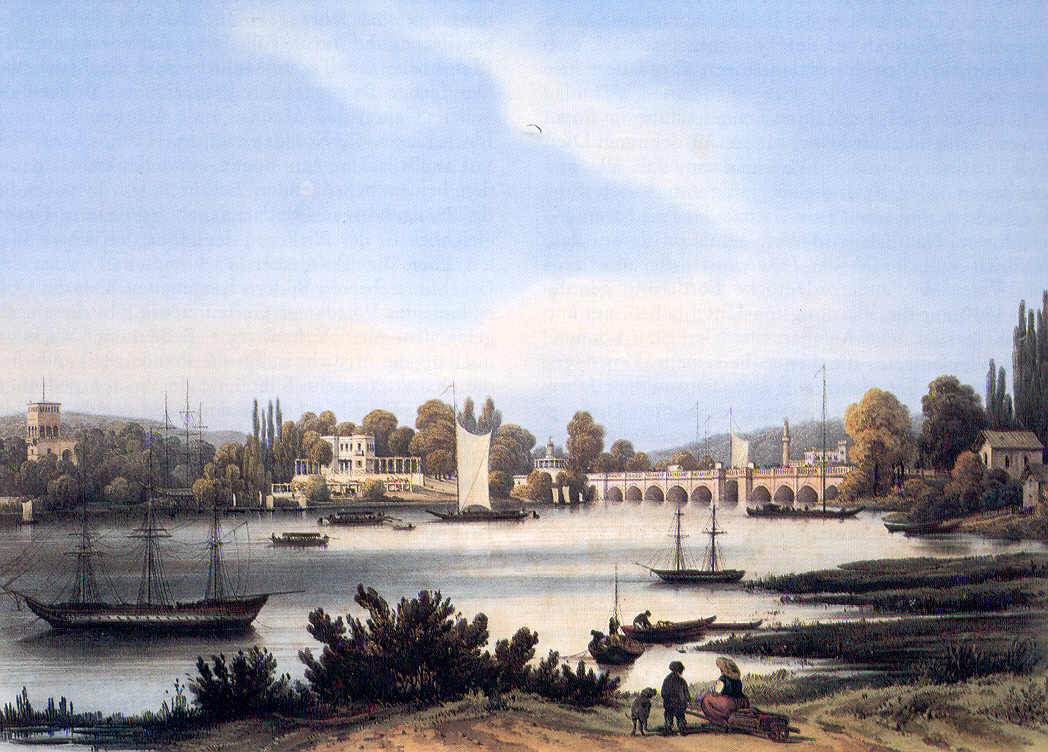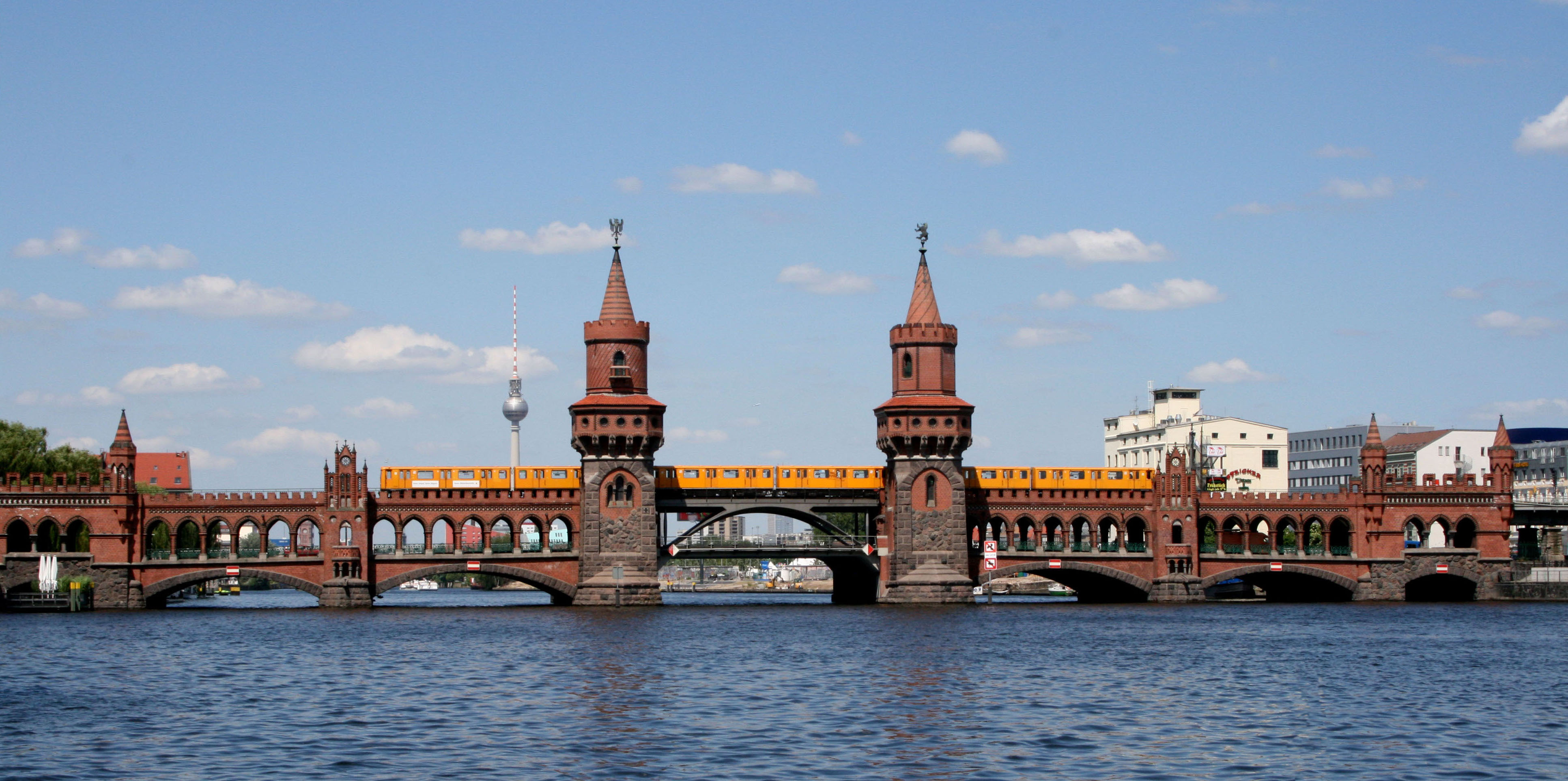The bridge is located in the very southeast corner of today Berlin (for the position pls. check out Map of Berlin and its (hi)stories) and connects it with the Brandenburg capital Potsdam. For some decades it was also a border bridge between the two German states.
But let´s start with the beginnings:
The first bridge
A narrow wood bridge was built around 1660 only for the nobility. They had the exclusive right to cross the bridge as a connection between their palaces in Potsdam and their hunting grounds on the other side of the river.
In 1754, the bridge was finally opened for a postal connection between Berlin and Potsdam.
The second bridge
In 1777 it was replaced by another wooden bridge, now with railings on its edges (see [P1]). For crossing it, a toll had to be paid (of course, nobility had exclusive rights again and didn´t have to pay anything:). Guard houses and moveable barriers were placed on its entrances to make sure the toll was paid by everyone.
Some years later the Prussian king of that time initiated the construction of so-called 'Chaussees' (old-fashioned, originally French name for well built country road) in his kingdom to strenghten its infrastructure. In 1793 Glienicker Brücke became integrated in such a new street connection, the 'Berlin-Potsdamer Chaussee'. Now the bridge was part of the main road connection between Berlin and Potsdam. In order to refinance the construction works and the maintenance , Chaussee users generally had to pay a toll which was collected by officials residing in so-called Chaussee houses ('Chaussee-Häuser') next to the roads every some kilometers. At Glienicker Brücke such a house was also erected and fullfilled this function for around 40 years. With the construction works for the replacement of the wood bridge and the extension of the Glienicke Park, it was demolished.
 |
| [P1] The Glienicke Bridge with the draw bridge in its middle and the hunting lodge Glienicke, 1788, by Nagel (SPSG Potsdam) [Public domain], via Wikimedia Commons |
Schinkel´s bridge
The new Glienicke Bridge, now made of stone, was built from 1832 to 1834 (see [P2] and [P3]). It was the work of well-known architect Karl Friedrich Schinkel. Like its prede- cessor, it had a draw bridge part in its middle. From a rotunda, also built by Schinkel as an extension of the Glienicke park, replacing the demolished Chausseehaus, contemporaries had a view on the driveway of the bridge and to the surrounding landscape.
 |
| [P3] Casino and bridge Glienicke ,painting by Franz Xaver Sandmann, around 1845, Franz Xaver Sandmann [Public domain], via Wikimedia Commons |
With the opening of the Teltow Canal in 1906, back then a new important water way which ended in the waters close to the bridge, it became necessary to enable the passage of larger ships. This resulted - in addition to the increasing traffic, the road on the bridge was just six meters wide - in the demolition of this third Glienicker Brücke, an incident which even at that time let preservationists protest..*
*At this point I would like to give a personal critic:
I also favor the demolished Schinkel bridge
regarding the design, especially because in my eyes its masonry and
flatness harmonised much more with its surroundings, namely the
Glienicke palace, the Villa Schoeningen and the Babelsberg Palace which
are all in sight. Maybe there could have been a more harmonic solution
as an answer to the increasing traffic, but the now existing bridge as a
symbol of east west separation and reunification deserves to be
pre- served anyway.
The 'Kaiser Wilhelm Brücke' (fortunately the name didn´t gain acceptance)
The new bridge, a suspension-bridge-like steel framework, was erected between 1906 and 1907 by the bridge building company Harkort, based in the German city Duisburg.
The roadway was now 13m wide accompanied by a 3m wide pedestrian way on both sides (see [P4]).
 |
| [P4] The bridge at the beginning of 20.century, colonnades in the foreground, own photo |
The opening in the middle for ships was 73 m wide now and the clear height for below the bridge was enlarged so that a draw bridge was not necessary anymore. The whole construction weighted 1,400 tons. On the Potsdam side, two stone colonnades in neo-baroque style were erected [P4] as an entrance to the bridge. In 1908, two artworks of the sculptor Stephan Walter were placed on the Berlin side: Stone Centaurs, mythical creatures of ancient Greece
(see [P6] foreground). The top of the pylones, carrying the hanging steel construction, were acentuated by little gracile towers. They were removed in the year 1931 in order to simplify the the maintenance and repair.
Destruction
In 1945 the German troops installed explosive devices on the bridge in order to prevent the Soviet troops to enter Potsdam coming from Berlin Wannsee. Anyway the Soviets came from the Potsdam side already. A Soviet grenade hit some of the explosives which destroyed the middle part of the bridge. After the end of the war the Soviets erected a wooden bridge near the destroyed one making the crossing possible for the Allied military. The reconstruction of the bridge lasted from 1947 to 1949. The steel was heaved out of the river by a lifting system and the construction was renewed and simplified by removing the pedestrian ways on the sides. The bridge was then reopened under the name 'Brücke der Einheit' (German for 'Bridge of unity'). From today´s point of view this sounds really ironic, keeping in mind that here the border between the two German states was situated for around 50 years.
The 'bridge of spies'
From 1949 on, the border between East and West was located directly in the middle of the bridge, marked by a white line. The Potsdam side was part of the German Democratic Republic (GDR) which was actually everything but demo- cratic and a satellite state of the Soviet Union. The Berlin side was part of 'West-Berlin' which belonged to West Germany and was base to the Western Allies France,
Great Britain and USA who had their own 'sectors' in the city. Glienicker Brücke was located in the US controlled southwest sector. After being open to public for around 230 years the bridge was again closed. For a long time only military personnel, diplomats and people with special permission were allowed to cross it. In the coming Cold War decades it would gain importance as a place where spies of both sides were exchanged.
The first exchange took place in 1962: The American pilot Francis Gary Powers, whose U2 reconnaissance aircraft was shot above Soviet Union two years before was exchanged at Glienicker Brücke with the Soviet spy Rudolf Iwanowitsch Abel.
Around 20 years later, in 1985, 23 Western spies were exchanged for 4 Eastern spies.
The third and final exchange took place in 1986: Three Western spies and one oppositional who was accused of spying by the Soviet Union, Anatoli Schtscharanski, were set free for five Eastern spies. The case of Schtscharanski was especially difficult because the Soviets wanted the West to declare he was a spy as a precondition for his release but the Western officials saw him as a political prisoner. In the end the negotiations were successful and he was among the released.
Today
After the fall of the wall, the bridge is again open for everyone and a frequented tourist site. A plaquette on the pedestrian walk marks the former border line. Now the bridge is, similar to the Brandenburg gate in my eyes, again an example for an architecture that is a symbol for connecting people and unification. Since 1990 the bridge is listed as a World Heritage Site.
 |
| [P6] The bridge in October 2015, own photo |
Preservation
 |
[P7] Northern colonnade,
with wooden reinforcements
|
a German foundation for preserving historical monuments, is collecting money these days. The southern colonnades were already renewed. The northern part still waits for reno- vation.. Check out the Link to the 'Stiftung' on the right side of this page in case you are interested to learn more or support (site is in German).
Tips
If you plan a trip to Potsdam and have a bit more time than just to see the city centre it´s a nice opportunity to drop by at Glienicker Brücke in addition to for example a visit to Villa Schöningen (Spy museum) or the Glienicke Palace. Another highlight, fitting to the bridge site: Cecilienhof Palace nearby in which the Western powers´ (Stalin, Churchill, Truman) Potsdam Conference took place.
Last but not least: The movie of Steven Spielberg, 'Bridge of spies' could be interesting to view in cinemas in the coming days.
 |
| [P8] Colonnades on Potsdam side, the one on the right already renovated, own photo |


